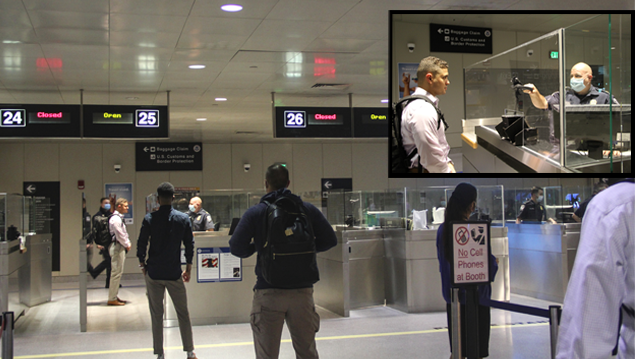 BOSTON — U.S. Customs and Border Protection (CBP) today announced the implementation of Simplified Arrival at Boston Logan International Airport (BOS).
BOSTON — U.S. Customs and Border Protection (CBP) today announced the implementation of Simplified Arrival at Boston Logan International Airport (BOS).
Simplified Arrival is an enhanced international arrival process that uses facial biometrics to automate the manual document checks that are already required for admission into the United States. This process provides travelers with a touchless process that further secures and streamlines international arrivals while fulfilling a longstanding Congressional mandate to biometrically record the entry and exit of non-U.S. citizens.
“Simplified Arrival introduces new efficiencies that will save time during the inspection process,” said Michael Denning, CBP Director of Field Operations for the Boston Field Office. “Reducing the need to capture fingerprints and handle travel documents will create a secure, modern and seamless experience for arriving travelers.”
Simplified Arrival only uses the biometric facial comparison process at a time and place where travelers are already required by law to verify their identity by presenting a travel document such as a passport. When travelers arrive at BOS on an international flight, they will pause for a photo at the primary inspection point. CBP’s biometric facial comparison process will compare the new photo of the traveler to a small gallery of high-quality images that the traveler has already provided to the government, such as passport and visa photos. In addition, foreign travelers who have traveled to the U.S. previously will no longer need to provide fingerprints as their identity will be confirmed through the touchless facial comparison process.
Simplified Arrival pairs one of the industry’s highest ranked facial comparison algorithms (as assessed by the National Institute of Standards and Technology) with trained CBP officers who are skilled at verifying the authenticity of travel documents. If a traveler cannot be matched to a photo on record using the Simplified Arrival process, the traveler will proceed through the traditional inspection process consistent with existing requirements for entry into the United States.
Travelers who wish to opt out of the new biometric process may notify a CBP officer as they approach the primary inspection point. These travelers will still be required to present a valid travel document for inspection by a CBP officer and they will be processed consistent with existing requirements for admission into the United States.
CBP is committed to its privacy obligations and has taken steps to safeguard the privacy of all travelers. CBP employs strong technical security safeguards and limits the amount of personally identifiable information used in the facial biometric process. New photos of U.S. citizens are deleted within 12 hours. Photos of most foreign nationals will be stored in a secure Department of Homeland Security system.
CBP and its air travel partners are expanding the use of facial biometrics through public-private partnerships to not only fulfill the Congressional security mandate, but also to further secure and enhance touchless travel wherever identity verification is required for international travel. The Simplified Arrival process complements facial biometric boarding to further secure and enhance the customer experience.
To date, more than 55 million travelers have participated in the biometric facial comparison process at air, land and sea ports of entry. Since September 2018, CBP has leveraged facial biometrics to prevent nearly 300 imposters from illegally entering the United States by using genuine travel documents that were issued to other people.
More information about CBP’s efforts to secure and streamline travel through facial biometrics is available here.

